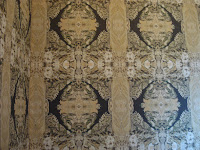By Nancy Day

July in Italy is usually dry and hot, cooling off after sunset to create the perfect ambience for outdoor opera, which starts at 9:15.
I saw
Die Zauberflote, written by Wolfgang Amadeus Mozart and usually performed in German, in Italian (
Il Flauto Magico) at the Boboli Gardens in Florence, and Carmen, set in Spain, written and performed in French by George Bizet, at the centuries-old Roman arena in Verona.
The Magic Flute cost 44 Euros (ticket bought on the Internet) and lasted well past midnight on this weeknight. The Queen of the Night was appropriately domineering and performed the challenging coloratura of her demanding second aria skillfully. The other singers I particularly liked were the trio of angelic-sounding boys who appear periodically as chorus. The audience of all ages was composed primarily of Italians. The setting is lovely, surrounded by gardens and fountains on the south side of the River Arno, with a capacity on bleacher-like seats of 3,000.
I walked from my apartment near the Duomo, but you can also take a bus or taxi to the entrance.
My daughter and I went to Verona to see Carmen, arranged by Fun Florence, an activities service targeting the thousands of international students who study abroad here. For 80 Euros, we made the trip north to Verona in an air-conditioned bus, complete with monitors and DVD player. To get in the mood for Verona, we watched the 1996 Baz Lurhrmann movie version of Romeo and Juliet, starring Leonardo DiCaprio and Claire Danes, updated to the mythical “Verona Beach” where fast cars and gang feuds rule. We arrived in the real Verona, riverside, no beach, in late afternoon and took a walking tour, first stop, the tourist-clogged Juliet’s house.
Verona is a beautiful city, calmer than others we visited, dominated in its historic center by the Roman amphitheatre, built in the first century AD and seating nearly 20,000. Since 1913, opera has been staged there every summer.
We were advised to take – or rent – pillows to make sitting on the pink marble more palatable, but that turned out to be the least of our problems in seeing this famous opera in four acts. (People who pay more have reserved actual seats, but the hoi polloi of general admission find seats where they can higher up and are free to go and come during the evening.)
Matters began promisingly when the gong lady came out to announce the opera’s start. The full orchestra filed in and began the well-known overture. Audience members lit candles, handed out free at the doors. Then donkeys and dancing girls and what looked like a cast of hundreds entered the main stage and two side ones. The nearly full moon slipped in and out of high clouds at the stage end of the amphitheatre; soon lightning cut the sky at the other end. And then came the rains.
People fled to the exits, but not as fast as the professional musicians gathered up their expensive instruments and sought shelter. The audience huddled close together in the covered passageways and came back when the rain abated. After all, Carmen had not yet made her first entrance. This routine was repeated three times.
Announcements were made in Italian, German and English. The gong lady dutifully reappeared after each break in the weather to signal another try. (A woman in period dress who came on the stage by herself to start – or restart – the proceedings with a series of increasingly strong gong hits.)
The orchestra returned, to much applause. The animals and players returned. The overture was skipped and we got right into the lovely Michaela coming to the crowded square to tell Don Jose news of his mother, immediately followed by more lightning and thunder and another rush to shelter.
Around midnight, the troupers tried again. This time, Carmen had the chance to sing her two arias in the first act, before the announcements in three languages revealed that the local weather authorities said the weather was “stable,” which for this evening, July 23, 2010, meant that we could expect more showers and thunderstorms, so the performance was canceled.
Those of us still awake watched the full version of the opera, filmed in Verona, on the way back to Florence, as it did, indeed, keep raining.
Since rain is rare, however, I still recommend the trip. The costumes are stunning, the animals and children beautifully behaved, the singers and musicians magnificent. If I said in Chicago or New York that I got drenched at the opera, people would laugh. But it was worth it here in the heart of Italy to experience opera as people have since the art form was invented.
More information:
http://www.arena.it/en-US/HOMEen.html
www.florenceforfun.com
http://www.festivalopera.it/incms/opencms/operafestival_en/sito-operafestival_en/Contenuti_operafestival_en/locations/visualizza_asset.html?id=429&pagename=480
www.festivalopera.it
Atmospheric photos from the cheap seats
























.jpg)

.jpg)
























